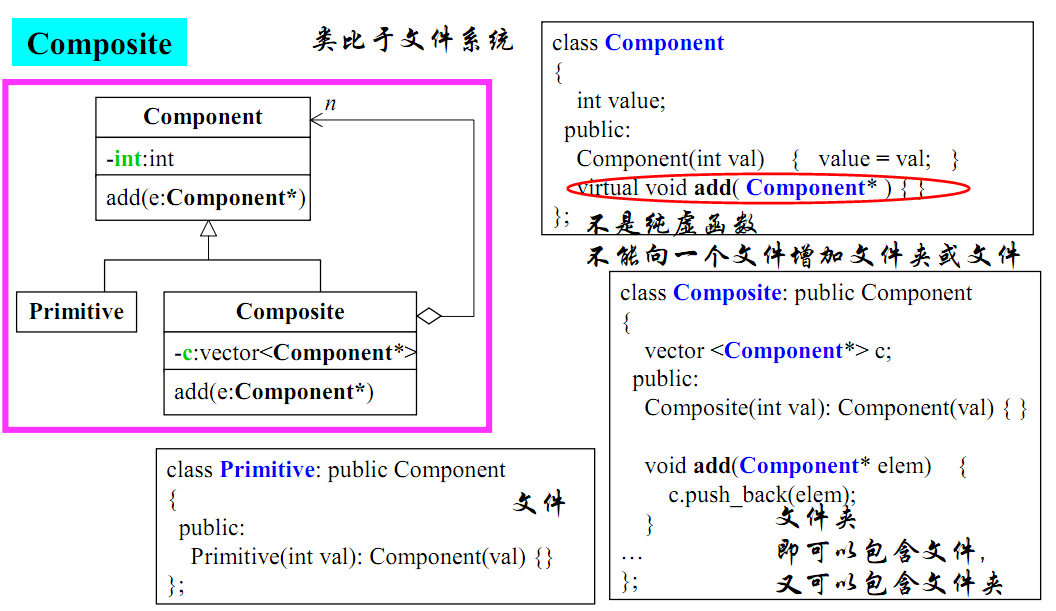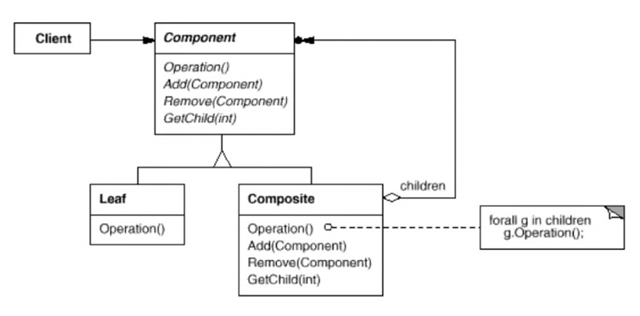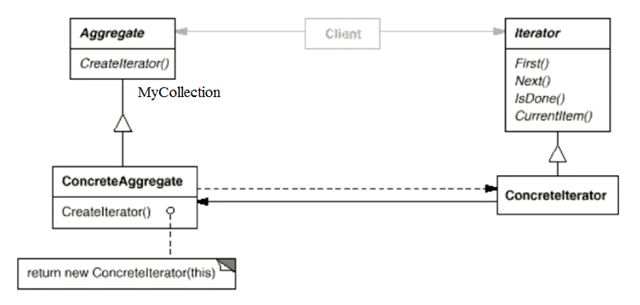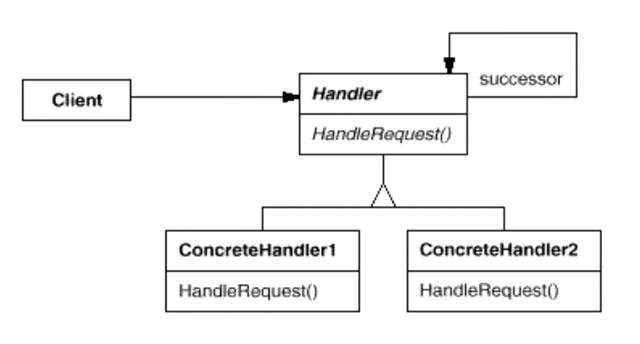设计模式8:“数据结构”模式——Composite,Iterator,Chain of Responsibility
“数据结构”模式
常常有一些组建在内部具有特定的数据结构,如果让客户程序依赖这些特定的数据结构,将极大的破坏组件的复用。这时候,将这些数据结构封装在内部,在外部提供统一的接口,来实现与特定数据结构无关的访问,是一种行之有效的解决方案。
典型模式
- Composite
- Iterator
- Chain of Responsibility
Composite 组合模式
动机(Motivation)
- 软件在某些情况下,客户代码过多地依赖于对象容器复杂的内部实现结构,对象容器内部实现结构(而非抽象接口)的变化将因其客户代码的频繁变化,带来了代码的维护性、扩展性等弊端。
- 如何将“客户代码与复杂的对象容器结构”解耦?让对象容器自己来实现自身的复杂结构,从而使得客户代码就像处理简单对象一样来处理复杂的对象容器?
模式定义
将对象组合成树形结构以表示“部分-整体”的层级结构。Compisite使得用户对单个对象和组合对象的使用具有一致性 (稳定)。
——《设计模式》GoF
示例伪代码:

1 #include <iostream> 2 #include <list> 3 #include <string> 4 #include <algorithm> 5 6 using namespace std; 7 8 class Component 9 { 10 public: 11 virtual void process() = 0; 12 virtual ~Component(){} 13 }; 14 15 //树节点 16 class Composite : public Component{ 17 18 string name; 19 list<Component*> elements; 20 public: 21 Composite(const string & s) : name(s) {} 22 23 void add(Component* element) { 24 elements.push_back(element); 25 } 26 void remove(Component* element){ 27 elements.remove(element); 28 } 29 30 void process(){ 31 32 //1. process current node 33 34 35 //2. process leaf nodes 36 for (auto &e : elements) 37 e->process(); //多态调用 38 39 } 40 }; 41 42 //叶子节点 43 class Leaf : public Component{ 44 string name; 45 public: 46 Leaf(string s) : name(s) {} 47 48 void process(){ 49 //process current node 50 } 51 }; 52 53 54 void Invoke(Component & c){ 55 //... 56 c.process(); 57 //... 58 } 59 60 61 int main() 62 { 63 64 Composite root("root"); 65 Composite treeNode1("treeNode1"); 66 Composite treeNode2("treeNode2"); 67 Composite treeNode3("treeNode3"); 68 Composite treeNode4("treeNode4"); 69 Leaf leat1("left1"); 70 Leaf leat2("left2"); 71 72 root.add(&treeNode1); 73 treeNode1.add(&treeNode2); 74 treeNode2.add(&leaf1); 75 76 root.add(&treeNode3); 77 treeNode3.add(&treeNode4); 78 treeNode4.add(&leaf2); 79 80 process(root); 81 process(leaf2); 82 process(treeNode3); 83 84 }
模式应用:类比于文件系统
结构
要点总结
- Composite模式采用树形结构来实现普遍存在的对象容器,从而将“一对多”的关系转化为“一对一”的关系,使得客户代码可以一致地(复用)处理对象和对象容器,无需关心处理的是单个对象还是组合的对象容器。
- 将“客户代码与复杂的对象容器结构”解耦是Composite的核心思想,解耦之后,客户代码将与纯粹的抽象接口——而非对象容器的内部实现结构——发生依赖,从而更能“应对变化”。
- Composite模式在具体实现中,可以让父对象中的子对象反向追溯;如果父对象有频繁的遍历需求,可使用缓存技巧来改善效率
Iterator 迭代器
动机(Motivation)
- 在软件构建过程中,集合对象内部结构常常变化各异。但对于这些集合对象,我们希望在不暴露其内部结构的同时,可以让外部客户代码透明的访问其中包含的元素;同时这种“透明遍历”也为“同一种算法在多种集合对象上进行操作”提供了可能。
- 使用面向对象技术将这种遍历机制抽象为“迭代器对象”为“因对变化中的集合对象”提供了一种优雅的方式。
模式定义
提供一种方法顺序访问一个聚合对象中的各个元素,而又不暴露(隔离变化,稳定)该对象的内部表示。
——《设计模式》GoF
示例伪代码

1 template<typename T> 2 class Iterator 3 { 4 public: 5 virtual void first() = 0; 6 virtual void next() = 0; 7 virtual bool isDone() const = 0; 8 virtual T& current() = 0; 9 }; 10 11 template<typename T> 12 class MyCollection{ 13 14 public: 15 16 Iterator<T> GetIterator(){ // 返回迭代器 17 //... 18 } 19 }; 20 21 template<typename T> 22 class CollectionIterator : public Iterator<T>{ 23 MyCollection<T> mc; 24 public: 25 26 CollectionIterator(const MyCollection<T> & c): mc(c){ } 27 28 void first() override { 29 30 } 31 void next() override { 32 33 } 34 bool isDone() const override{ 35 36 } 37 T& current() override{ 38 39 } 40 }; 41 42 void MyAlgorithm() 43 { 44 MyCollection<int> mc; 45 46 Iterator<int> iter= mc.GetIterator(); 47 48 for (iter.first(); !iter.isDone(); iter.next()){ 49 cout << iter.current() << endl; 50 } 51 52 } 53 54 55 // 虚函数调用性能成本 56 57 // stl 迭代器使用模板(编译时多态),性能高于面向对象的迭代器(运行时多态) 58 59 // 思想不会过时,实现技术已经过时
结构
Chain of Resposibility
动机(Motivation)
- 在软件构建的过程中,一个请求可能被多个对象处理,但是每个请求在运行时只能有一个接受者,如果显示指定,将必不可少的带来请求发送者与接受者的耦合。
- 如何使请求的发送者不需要指定具体的接受者?让请求的接受者自己在运行时决定来处理请求,从而使两者解耦。
模式定义
使多个对像都有机会处理请求,从而避免请求的发送者和接收者之间的耦合关系。将这些对像连成一条链,并沿着这条链传递请求,直到有一个对象处理它为止。
——《设计模式》GoF
示例伪代码

1 #include <iostream> 2 #include <string> 3 4 using namespace std; 5 6 enum class RequestType 7 { 8 REQ_HANDLER1, 9 REQ_HANDLER2, 10 REQ_HANDLER3 11 }; 12 13 class Reqest 14 { 15 string description; 16 RequestType reqType; 17 public: 18 Reqest(const string & desc, RequestType type) : description(desc), reqType(type) {} 19 RequestType getReqType() const { return reqType; } 20 const string& getDescription() const { return description; } 21 }; 22 23 class ChainHandler{ 24 25 ChainHandler *nextChain; 26 void sendReqestToNextHandler(const Reqest & req) 27 { 28 if (nextChain != nullptr) 29 nextChain->handle(req); 30 } 31 protected: 32 virtual bool canHandleRequest(const Reqest & req) = 0; 33 virtual void processRequest(const Reqest & req) = 0; 34 public: 35 ChainHandler() { nextChain = nullptr; } 36 void setNextChain(ChainHandler *next) { nextChain = next; } 37 38 39 void handle(const Reqest & req) 40 { 41 if (canHandleRequest(req)) 42 processRequest(req); 43 else 44 sendReqestToNextHandler(req); 45 } 46 }; 47 48 49 class Handler1 : public ChainHandler{ 50 protected: 51 bool canHandleRequest(const Reqest & req) override 52 { 53 return req.getReqType() == RequestType::REQ_HANDLER1; 54 } 55 void processRequest(const Reqest & req) override 56 { 57 cout << "Handler1 is handle reqest: " << req.getDescription() << endl; 58 } 59 }; 60 61 class Handler2 : public ChainHandler{ 62 protected: 63 bool canHandleRequest(const Reqest & req) override 64 { 65 return req.getReqType() == RequestType::REQ_HANDLER2; 66 } 67 void processRequest(const Reqest & req) override 68 { 69 cout << "Handler2 is handle reqest: " << req.getDescription() << endl; 70 } 71 }; 72 73 class Handler3 : public ChainHandler{ 74 protected: 75 bool canHandleRequest(const Reqest & req) override 76 { 77 return req.getReqType() == RequestType::REQ_HANDLER3; 78 } 79 void processRequest(const Reqest & req) override 80 { 81 cout << "Handler3 is handle reqest: " << req.getDescription() << endl; 82 } 83 }; 84 85 int main(){ 86 Handler1 h1; 87 Handler2 h2; 88 Handler3 h3; 89 h1.setNextChain(&h2); 90 h2.setNextChain(&h3); 91 92 Reqest req("process task ... ", RequestType::REQ_HANDLER3); 93 h1.handle(req); 94 return 0; 95 } 96 97 // 职责链在今天用的不多,可以说就是一种数据结构
结构
要点总结
- Chain of Responsibility模式的应用场合在于“一个请求可能有多个接受者,但是最后真正接受者只有一个”,这时候请求发送者与接受者的耦合可能出现“变化脆弱”的症状,职责链的目的就是将二者解耦,从而更好的应对变化。
- 应用了Chain of Responsibility模式后,对象的职责分派将更具灵活性。我们可以在运行时动态添加/修改请求的处理指责。
- 如果请求传递到职责链的末尾仍得不到处理,应该有一个合理的缺省机制。这也是每一个接受者对象的责任,而不是发出请求的对象的责任。
小结
Composite
将对象组合成树形结构以表示“部分-整体”的层次结构。Composite 使得用户对单个对象和组合对象的使用具有一致性。
- 你想表示对象的部分-整体层次结构。
- 你希望用户忽略组合对象与单个对象的不同,用户将统一地使用组合结构中的所有对象。
Iterator
意图
提供一种方法顺序访问一个聚合对象中各个元素, 而又不需暴露该对象的内部表示。适用性
- 访问一个聚合对象的内容而无需暴露它的内部表示。
- 支持对聚合对象的多种遍历。
- 为遍历不同的聚合结构提供一个统一的接口(即, 支持多态迭代)。
Chain of Responsibility
意图
使多个对象都有机会处理请求,从而避免请求的发送者和接收者之间的耦合关系。将这些对象连成一条链,并沿着这条链传递该请求,直到有一个对象处理它为止。适用性
- 有多个的对象可以处理一个请求,哪个对象处理该请求运行时刻自动确定。
- 你想在不明确指定接收者的情况下,向多个对象中的一个提交一个请求。
- 可处理一个请求的对象集合应被动态指定。
本文内容源自 :C++设计模式 Design Patterns 李建忠 课程








